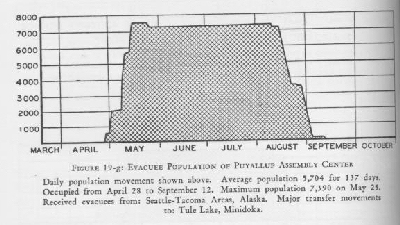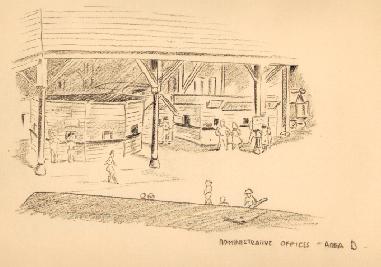Camp: Administration
The Puyallup Assembly Center was under the jurisdiction of the Wartime Civilian Control Administration (WCCA) and the center manager, J.J. McGovern. The day-to-day administration of the camp, that one scholar called "the most thoroughgoing example of self-government" evident at the assembly centers, was in the hands of a select group of Japanese American Citizens League (JACL)members.1
The Japanese American governing board was based on a military model with a headquarters staff and a corresponding structure in each of the camp's four areas. All information from the inmates to the WCCA staff was funnelled through this governing structure and WCCA directives were disseminated through the governing board to the inmates.
James Y. Sakamoto, chair of the Emergency Defense Council, former national leader of the Japanese American Citizens League, was the chief supervisor. The situation in Puyallup was unique.
Nowhere else did inmates have as much direct control over other inmates; in addition, nowhere else was the characteristic collective or group leadership of the Japanese American community replaced by the leadership of a dynamic individual. The leader was James Y. Sakamoto, a maverick whose flamboyant life and career would have stood out in any prewar ethnic community but nowere more so than in contrast with the "grey flannel" conservative style adopted by almost all the other successful Japanese American leaders.2
This self-imposed government of the Japanese American Citizens League did not go without complaint. A vote of confidence was taken in June and the JACL did win the support of the camp following a controversial non-secret ballot vote. The dissidents demanding this vote of confidence were later scattered by the authorities to different camps.
Notes:
1. Daniels, Roger. Asian America: Chinese and Japanese in the United States since 1850. Seattle: University of Washington Press, pg. 235.
2. Ibid, pg. 236.
|
Administrative Offices - Area D. Eddie Sato Sketchbook and Drawings. Manuscripts and University Archives Division, UW Libraries. |
_ |
|
Letter from Bill Hosokawa of the Emergency Defense Council Seattle Chapter of the Japanese American Citizens League dated May 7, 1942. Emergency Defense Council of the Seattle Chapter, Japanese American Citizens League. Box 18. Manuscripts and University Archives, UW Libraries. |
A headquarters staff was set up to administer the government of all areas. Set up on a military basis, it was divided into four sections: G-1 for personnel; G-2 for information; G-3 for operations; G-4 for supply, and a special section to take care of such matters as policing, fire watch, etc. This headquarters staff was to plan and set policy for the entire camp. Each of the four areas is to have its own area staff, planned on the same order as the headquarters staff. Each area is broken down into sections, each section into groups, and each group into sub-groups, with about 30 individuals in each sub-group. As you can see this is similar to Army structure where the breakdown is from division down to the platoons. The civilian director of the camp was prevailed upon to accept most of the features of the plan, and Area A is functioning already. Bill Mimbu, attorney, is installed as Area A supervisor. Jimmie Sakamoto is chief supervisor, in charge of all four camps. Fortunately Bob Turner, the civilian in charge of the camp, turned out to be a personal friend of Jimmie's. |
|
"Hdqtrs. Meet Clarifies Self-Government Set-Up." Camp Harmony News-Letter, May 14, 1942. |
Self-government for Camp Harmony moved closer toward maximum efficiency as available headquarters staff members met yesterday at the central offices in Area "D" to discuss coordination of all area activities. George Ishihara, personnel supervisor, was elected temporary chairman, pending arrival of Chief Supervisor James Sakamoto this Saturday. Staff members declared there was still considerable confusion among the camp's fast growing population as to the established administrative machinery and procedure to be followed in disposing of area problems and complaints. All section and area questions, it was agreed, must first be discussed by area councils. Area officers were advised not to take their difficulties directly to the Wartime Civilian Control Administration office. WCCA officials, according to headquarters, will not recognize issues unless they are presented by headquarters. All matters not settled by area councils are to be referred to headquarters, which in turn will deal directly with the WCCA office as a final resort. |
|
"Camp Harmony Japs Living Up to Name." Seattle Post-Intelligencer, May 25, 1942, pt 2, pg. 1. |
James Y. Sakamoto, former publisher of the Japanese American Courier and now chief Japanese supervisor of the camp has set up his headquarters underneath the grandstand on the fairgrounds and keeps busy from morning to night consulting with members of his staff. Bill Hosokawa, University of Washington graduate and former editor of a newspaper in Singapore is his chief adjutant. The headquarters staff is divided into five general sections, with George Ishihara, produce shipper, in charge of personnel; Jack Maki, associate in the Far Eastern department at the University of Washington, in charge of information; Dick Setsuda, beer distributor, in charge of operations; Thomas Iseri, Auburn produce shipper, in charge of supply, and Julius Fujihara, in charge of police, fire, postal and other services. Leaders of the four areas into which the center is divided are William Mimbu, attorney; Yakeo Nogaki and Teruji Umino, both bank clerks, and Hiroyuki ("Lefty") Ichihara, who had a fishing tackle store in Seattle. All of these executives, incidentally, are American-born Japanese. |
|
Police Report, Area A, no date. James Y. Sakamoto Papers. Box 10. Manuscripts and University Archives, UW Libraries |
Regulations
|
|
Report on the Evacuation and Relocation in the 13th Naval District (Seattle, Washington). Prepared by the District Intelligence Office, March 25, 1943. Papers of the U.S. Commission on Wartime Relocation and Internment of Civilians. Part 1, Numerical file archive. Reel 2 0337 [1532-1570] |
At the Puyallup Assembly Center the "Evacuee Adminstration Headquarters" under the leadership of James Yoshimori Sakamoto, blind editor and publisher of the Japanese-American Courier and past president of the Japanese-American Citizens League, succeeded in maintaining harmony and peace for a period of from six weeks to two months. Friction then broke out when a rival group led by Thomas Shinao Masuda and Kenji Ito, both Seattle nisei attorneys, who had just succeeded in gaining acquittal in Federal Court on charges of being unregistered agents of the Japanese government, challenged the Japanese American Citizens League groups authority. Sakamoto's supporters, in endeavoring to maintain their authority, adopted the stand that as loyal partriotic Americans the nisei should make the best of the camp, which was to be a temporary inconvenience at most, and do all possible to cooperate with the United States Government in every way. The opposition, led by Masuda and Ito and supported by most of the kibei group (American born but educated in Japan) and the most pro-Japan element among the alien body, argued that the internal camp administration was undemocratic and un-American because its officers were not duly elected by popular vote and that the Japanese-American Citizens League was a tool of the United States Government agencies such as the Army, Navy and Federal Bureau of Investigation, and had been remiss in its duty to its members and the Japanese community in general when it failed to fight the evacuation orders (at least as pertaining to the Nisei) in the courts. To ascertain the view of the Japanese in the Camp the Wartime Civil control Authorities Camp Supervisor called for a vote of confidence in the Japanese-American Citizens League and its administration set up at Camp Harmony. All evacuees at the center 15 years of age and older were given the opportunity to vote. An overwhelming vote of nearly five to one in favor of retaining the Japanese-American Citizens League internal adminstrative body resulted. |
|
"Landslide Majority Votes to Retain Japanese Staff". News Letter, Vol. 1, No. 7, June 17, 1942. |
Camp Harmony residents gave a landslide vote of approval to the incumbent Japanese administration staff through the plebiscite held last night and indicated thereby they were willing to leave the working of the camp in the hands of present headquarters and area administrators. Returns tabulated this morning showed that out of 5,545 persons who voted 4,064 indicated their desire to retain the present set-up while 1,119 were against the retention. Three hundred and sixty two persons did not vote. Balloting was restricted to those over 16 years of age. "The vote of confidence given us by residents of Camp Harmony will pave the way toward a smoother functioning at our relocation centers. Camp Harmony is merely a stop at the wayside but the experience here will go a long way toward unity, mutual cooperation and harmony at our future community," James Sakamoto, Chief Supervisor of the Japanese headquarters staff declared. |
|
"Evacuee Population of Puyallup Assembly Center." Graph 19-g in Final report, Japanese evacuation from the West coast, 1942. Washington D.C.: U.S. Government Printing Office, 1943 |
_
|

